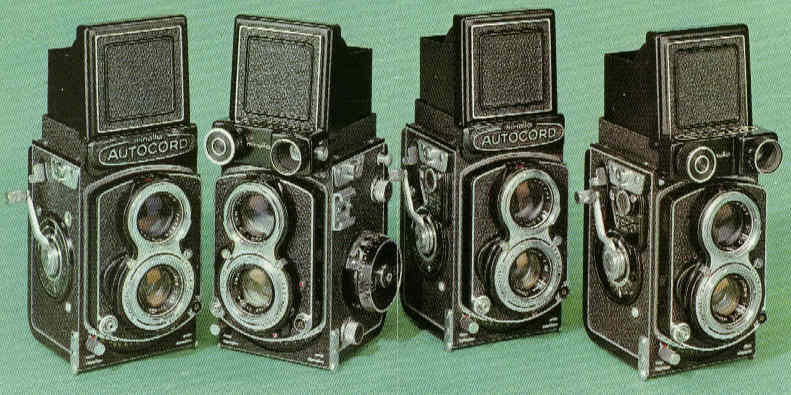
MINOLTA TLR CAMERAS

There are several confounding factors with Minolta TLRs, but it also applies to many other cameras of the same time period. The Minolta TLR cameras changed and evolved over time, but frequently the official name of the camera did not. For example, you might see the same name on a camera but with different lenses, different shutters or different features. In addition, these variations might be unoffically referred to as model I or model II, but Minolta never used those designations. In other instances, Minolta used the exact same name for cameras that are clearly very different.
To make matters worse, Minolta used various confusing names: Minoltacord, Minoltaflex, Minolta Autocord, Minolta Automat, Minoltaflex Automat, etc. It gets pretty messy. Keep all of this in mind when exploring these Minolta TLR cameras.
The later models used a bayonet filter style and Minolta made about a dozen different filters. Filters from other manufacturers can also be used. If you are able to provide more accurate information than is listed here, please contact us.

(1937) The Prince Flex has little to do with Minolta except that the Prince Flex was made by two former Minolta employees who left Molta (Minolta's original name) to start their own camera company, and produced the first Japanese-made TLR in the summer of 1937 -- something that Molta had been working on for over a year. Neumann and Heilemann (whose names appear in their new company's name, as well as on the Prince Flex TLR) were Germans living in Japan -- where German-made Rollei TLRs were very popular at the time. Neumann and Heilemann saw this as a great opportunity, and went on to make other TLRs -- but not nearly as many as Molta (soon-to-be-named, Minolta).

(1937) Although sometimes listed as a 1936 camera, Molta's first TLR was developed in 1936, but did not appear until at the end of 1937 -- shortly after the Prince Flex. Still, it has the honor of being the first TLR made in Japan to have a double-exposure prevention mechanism. Surprisingly, it bares the Minolta name, instead of Molta or Minoltaflex. It typically has a 75mm (f3.5) lens, and shutter speeds of B; 1 - 1/300, but is seen with different lenses (with different apertures) and different shutters (with different speed settings). It uses 120 film. It is often referred to as the Minoltaflex I to separate it from the later Minoltaflex models.
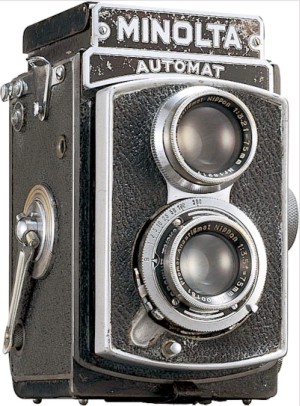
(1939) The first Japanese TLR to use the Rollei system of film advance -- the film is automatically stopped without the need to check numbers in a window. 75mm (f3.5) lens made by Asahi (of later Pentax fame). Shutter speeds of B; 1 - 1/300. Uses 120 film. Lots of minor variations over time.
(1943) A special military version with interchangeable lenses -- 75mm (f3.5) and 150mm (f4.5) lenses. Shutter speeds of T, B; 1 - 1/400. Uses 120 film or 35mm film.
(1948) This version was a prototype only, and never made it to market. Yet, it stands out because of its 85mm (f2.8) lens. Shutter speeds of B; 1 - 1/300. Uses 120 film. Interchangeable lenses.
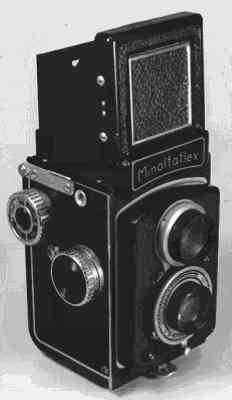
(1950) Often referred to as the Minoltaflex II (in an attempt to keep things straight), it was the first post-war, Minoltaflex model. More significantly, it is the first with a lens labeled "Rokkor" -- a 75mm f3.5 lens in a Konan (see Minolta's 16mm cameras) shutter with speeds of B; 1 - 1/500. Uses 120 film. There were minor variations over its two years of production.
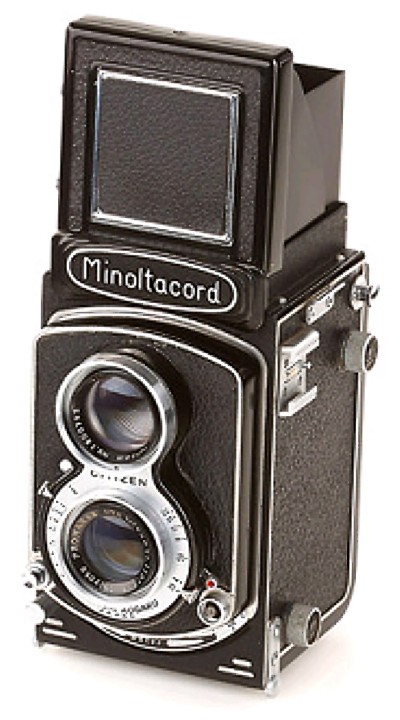
(1953) The first in a long line of popular TLRs that evolved into the Minolta Autocords, and lasted into the late 1960s. It has a 75mm f3.5-22 Promar lens made by Asahi. Uses 120 film. Two models existed using slightly different shutters, such as Citizen.
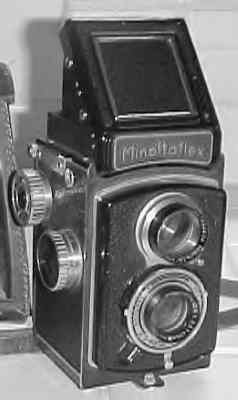
(1952) Yes, it was officially labeled the "II B" -- at least on the owner's manual. It has a 75mm (f3.5) lens and shutter speeds of B; 1 - 1/500. Uses 120 film.
(1954) The last TLR with the Minoltaflex name, it has a 75mm f3.5 lens. Shutter speeds of B; 1 - 1/500. Uses 120 film.

(1955) 75mm f3.5 lens. New, self-cocking shutter (with speeds of B; 1 - 1/500), plus auto-stop winding -- hence the "AUTO" in "AUTOCORD". And like other Minolta TLR cameras, this model saw minor variations over time, such as later models having a DOF scale under the film winding crank. Uses 120 film.

(1955) Minolta turned everything upside down with this model. In fact, they mounted the feeder and take-up spools backwards! Why would they do that? They determined that this would increase the tension on the film and create flatter film -- and hence sharper images. It later became standard practice in TLR cameras from most companies. It's called the "Automat" because the shutter is "automatically" cocked when the film is advanced -- unlike the earlier Minoltacord.
(1955) It has a 75mm f3.5 lens in an Optiper MXS shutter with speeds of B; 1 - 1/400. You can determine a Model A becasue it lacks a DOF scale under the film winding crank. Uses 120 film.
(1955) Yet another Minolta first, this was the first Japanese camera to be fitted with an built-in, EV-based, exposure meter -- and it made picture taking much more accurate. The selenium meter was not coupled to the shutter speed or aperture scale, but it was easy to use. First, dial in the film speed into the meter. Then the meter produces a single, EV number instead of an f-stop and shutter speed combination. This EV number -- Minolta called it an LVS number -- is then dialed into the shutter/lens assembly. The f-stop and shutter speeds are assigned LVS numbers and the combination must equal the LVS number from the meter. This system was used later on the 35mm Minolta SR-7, and other Minolta cameras and meters, as well. It sounds awkward, but it worked well -- once you got the hang of it. Otherwise, it's pretty much the same. It has a 75mm f3.5 lens in a Seikosha Rapid shutter with speeds of B; 1 - 1/500. Uses 120 film. Two models existed.
(1955) The difference in this model is the shutter. It has a 75mm f3.5 lens and an Optiper MXV shutter with speeds of B; 1 - 1/400. Uses 120 film.
(1956) 75mm (f3.5) lens. Shutter speeds of B; 1 - 1/400. Uses 120 film. It's the same as original MXS, but a depth-of-field scale was added to the side of the crank.

(1957) An unusual variant of the Autocord MXV, it allows for different images sizes. It retains the 75mm f3.5 lens, and Optiper MXV shutter with speeds of B; 1 - 1/400, and uses 120 film, but it has a removable panel just above the hub of the wind lever which allows different sets of gears to be installed by the user to generate film spacing for different film formats -- 6x6, 5x4 or 4x4.

(1958) An updated Autocord L with a built-in selenium meter. It has a the normal 75mm f3.5 lens, but it sports a Seikosha-MX shutter with speeds of B; 1 - 1/500, and X,F&M synch.
(1958) No, it isn't an abbreviation for "Revolving Back". That's irrelevant with the 6x6 format. It was designed to be an improved version of the RA because it has a shutter with speeds of B; 1 - 1/500. All other features were the same -- 75mm f3.5 lens, etc. -- but it was a prototype only.

(1959) Much smaller than the other Minolta TLRs because it used the smaller 127 film for 4x4 images instead of the 120 film which made 6x6 images. It has a shorter 60mm (f3.5) lens and shutter speeds of B; 1 - 1/500. Only about 5,000 of these were made so they get pricey.
(1961) It retains the trusty 75mm f3.5 lens, but now marked "Chiyoko Rokkor", and adds a Optiper MVL shutter with speeds of B: 1-1/500, and X & M sych. To top it off, it has a seft-timer. Uses 120 film.
(1961) 75mm (f3.5) lens. Shutter speeds of B; 1 - 1/500. Uses 120 film.
(1962) It has the 75mm f3.5 lens, now marked "Minolta Rokkor". Shutter speeds of B; 1 - 1/500. Uses 120 film.
(1962) Same 75mm f3.5 lens, but switched to an Optiper shutter with speeds of B; 1 - 1/500. Uses 120 film. It's the first Minolta TLR to be marked "Minolta Camera Co."
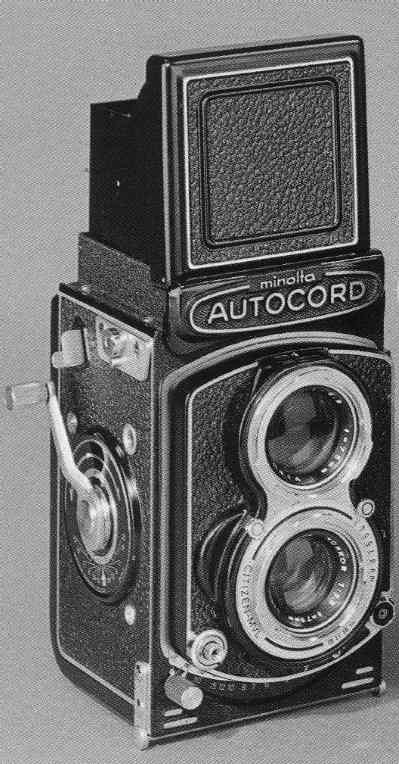
(1965) An updated version of the original Autocord. While this model is only marked "Autocord", the Minolta literature refers to it as the "Autocord Stardard" -- undoubtedly to distinquish it from the other Autocord model released at the same time (below). Despite this, some photographers refer to it as the Autocord I or Autocord model 1, which leads to a lot of confusion since it is not the first Autocord model, and the "I" or "1" never appear anywhere. It has a 75mm f3.5-22 Rokkor lens and a Citzen shutter with speeds of B; 1 - 1/500. Uses 120 film. It has built-in double-exposure control -- and over-ride. M and X synch at all shutter speeds. Built-in pop-up magnifier and eye-level sport finder. Built-in self-timer and cold flash shoe.
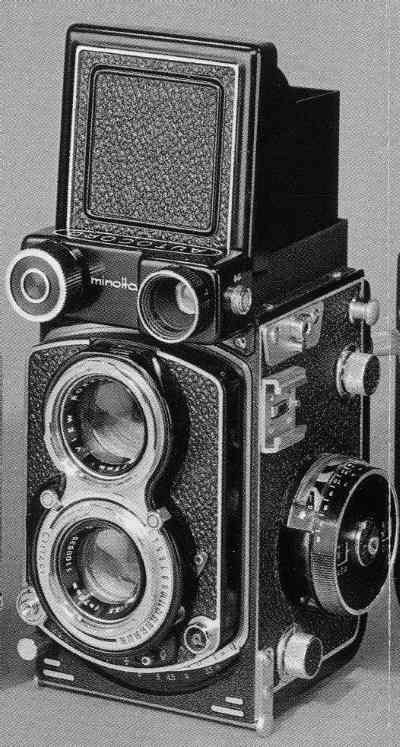
(1965) The Autocord CDS is an improved version of the Autocord Standard (above), with a built-in CDS meter. The meter is built into a panel above the lens and meters a 15 degree angle (designed for semi-spot metering) -- viewable as a large circle in the middle of the focusing screen. It accepts film speeds from ISO 6 to 25,000 and has a HIGH and a LOW setting -- as well as OFF. The meter uses an EV scale on a large knob on the left side of the camera -- making it easy to read from the viewing position. Uses a single PX-1 battery or equivalent.
(1966) Not a big update for many, but it was enough to make it into the history books. While it still has the trusty 75mm f3.5 Rokkor lens, and Citizen shutter with speeds of B; 1 - 1/500, this was the first Japanese TLR camera designed to use 120 film or 220 film -- by rotating the pressure plate. Since the film counter only ran to "12", with 220 film the counter was reset to "0" for the 13th through 24th exposure. It was short-lived and quickly replaced by the Autocord III, so it is hard to find.
(1966) Improved version of the Autocord II with a built-in CDS meter. It was short-lived and quickly replaced by the Autocord CDS III, so it is hard to find. Uses a single PX-1 battery or equivalent.

(1966) There was one more improvement to make in the final TLR cameras that Minolta would make. It has the same 75mm (f3.5) lens. It has the same shutter with speeds of B; 1 - 1/500. And it's designed to accept 120 or 220 film by rotating the pressure plate -- BUT without having to reset the counter after the 12th picture! The film counter can be set for 12 (120) or 24 (220) shots.
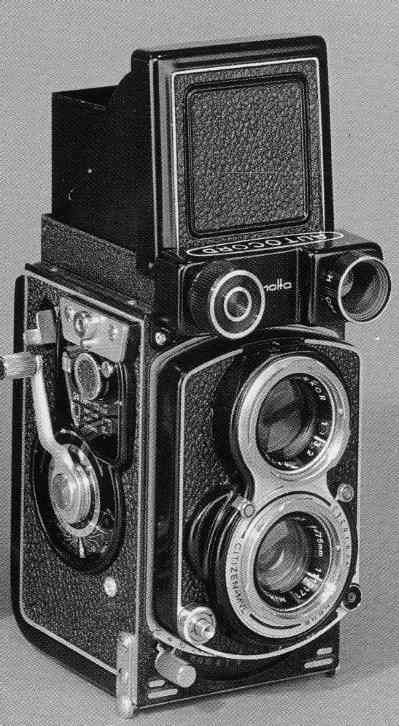
(1966) Improved version of the Autocord III with a built-in CDS meter. Uses a single PX-1 battery or equivalent.
We didin't want to do this, but since other websites have been stealing our stuff, we have no alternative but
to state:
COPYRIGHT@1995-2025 by Joe McGloin. All Rights Reserved. The material on this website is protected by US Federal
copyright laws. It cannot be copied without approval from the owner.